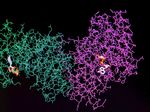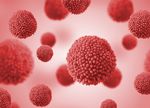Partnerships and collaborations - Changing the way we see life - Rosalind Franklin Institute
←
→
Page content transcription
If your browser does not render page correctly, please read the page content below
About The Rosalind Franklin Institute Biological applications
T O
he Rosalind Franklin Institute is the UK’s life science focused national interdisciplinary research ur technologies will be exploited across a breadth of disease areas, however, to ensure the
Institute, based in the UK’s Golden Triangle, with member organisations across the UK. Our biological relevance of our tools, we have a science focus on infection and the body’s response
research teams of engineers, physicists, biologists and chemists are creating new technologies to it. Using our technologies, we can image the shape and chemistry of life at a cellular level in
which will transform our ability to visualise and probe cellular life. These technologies will be applied both pathogens and human cells, and develop protein tools which have applications in imaging, and
to the most important research challenges in life science and medicine. potential development capabilities as therapeutics and diagnostics.
Our technologies are unique, ambitious, and The Franklin ‘Factor-of-Ten’ is a rule of thumb metric
developed in partnership with industry and academia we apply to our technologies. We will not invest in
AMR:
to ensure they will benefit the research community. projects which offer only incremental advances, or
Antimicrobial resistance is widely acknowledged as
Based at The Franklin hub throughout their those which could be undertaken by a single party
one of the principal threats to human health in coming
development, our tools can give industry access to acting alone under grant funding. Instead, we focus
decades, already accounting for 700,000 deaths per year
beyond state of the art technologies in advance of our resources on ‘factor of ten’ shifts – on tools which
and rising.
their maturation into the community. create an order of magnitude change in the capability,
resolution, or capacity of a technique, to change the The economics of antibiotic development are
way we see life in a leap. unfavourable, but the need is higher than ever. Using
advanced technologies at The Franklin, we will better
understand mechanisms of resistance, we will observe
dynamic drug action in the cell, and our small molecule
and protein modification tools can be applied against
microbial disease.
Key techniques: Cellular tomography, In-cell chemistry,
High Throughput Discovery
Understanding viral action: Intracellular pathogens:
Electron tomography has already shown promise Intracellular pathogens, as diverse as malaria and
in visualising viral replication and infection. chlamydia, cause a huge burden of disease around
Understanding the biological mechanisms of viral the world, but their study is hampered by complex life
action offer the potential to understand both cycles, and difficulties in imaging.
existing and emerging diseases. Our tools in cellular
Imaging across multiple dimensions – in chemistry, time
tomography will advance this capability even
and space, could enable the action of novel compounds
further.
to be investigated, and will reveal fundamental
The ability to respond quickly to emerging viral biological mechanisms in these complex pathogens.
disease with novel reagents to image, diagnose The ability to track an antimicrobial drug through the
or treat pathogens essential. Nanobodies, tiny human cell to the pathogen would be enormously
antibodies derived from camelids, produced by valuable.
The Franklin, can be used to stabilise proteins for
Key technologies: In cell chemistry,
advanced imaging, but because of their specificity
Cellular tomography, PPUK, MSI
and stability, also show incredible promise as
therapeutics and diagnostics.
Key techniques: Protein Production UK (PPUK),
Mass Spectrometry Imaging (MSI)Key technologies for exploitation
O
ur work at The Franklin is driven by a clear aim of making transformative leaps forward in life
science. Five complementary scientific themes are together developing beyond-state-of-the-art
technologies that will allow us to see the biological world in new ways – from single molecules
to entire systems. These technologies, developed in partnership with industry and academia, can help
answer research problems across life science. We welcome collaborations to address your research
questions that would benefit from early access to these transformative technologies.
Protein Production UK: High throughput drug discovery:
Dedicated to creating faster, more effective A high throughput lab developed in collaboration
sample management for imaging in a number of with University of Leeds, which can develop and test
techniques, using X-rays or electrons. PPUK has workflows for small molecule synthesis. The ability to
a specialist capability in nanobody production – open chemical space to a wider and more adventurous
put to the test during the coronavirus pandemic, range of molecules is of vital importance to the
which saw novel nanobodies with nanomolar increasingly unproductive world of drug discovery. The
affinity for the SARS-CoV-2 spike protein Franklin can offer extensive cross theme partnerships,
engineered from library screens to publication meaning in addition to the high throughput lab, you can
in only 12 weeks. Nanobodies are already gain access to fragment screening, AI driven synthesis,
recognised for their utility in imaging, and their imaging and synthetic biologics.
potential as a therapeutic and diagnostic are
being investigated around the world.
In-cell chemistry and synthetic
Correlative Imaging Platforms: biologics:
Our Correlated Imaging team, led by Professor Protein modification carried out inside the cell is
Angus Kirkland, are working on a number of the ultimate aim of our chemistry theme. The team,
novel electron and optical imaging instruments. led by Professor Ben Davis, imagines the potential
In collaboration with JEOL we are developing of gentle, light driven protein modification as an
two new electron microscopes, both with time Cellular tomography: alternative to gene therapy. The techniques are also
resolved capability. The first is optimised for applicable to imaging, in conjunction with cellular
Supported by Wellcome, and in collaboration with
cryo electron Ptychography over a wide voltage tomography and other techniques.
Thermo Fisher Scientific, Professor James Naismith
range and the second, with Chromatic correction and the Structural Biology team are developing Control of cells through the “editing” of functional
for imaging thicker liquid and cryo samples. tools to enable true cellular tomography; cryo- biomolecules could allow reprogramming of events
Together with Associate Professor Marco electron imaging of large volumes. We have as diverse as inflammatory response to tissue
Fritzsche in collaboration with the Kennedy already seen the impact of electron imaging on formation. The team are developing methods to
Institute for Rheumatology at the University structural biology, with cellular tomography we break and form bonds in vitro and in vivo that can be
of Oxford we are constructing the Biophotonic will see a further factor of ten shift in capability. applied to, for example, selective change of proteins
Correlative Optical Platform (BioCOP). This Known as ‘Amplus’ the Franklin is leading and glycans. These include attractive targets such
system will provide high performance optical global efforts in cellular tomography, with as proteoglycans for such chemical editing as their
imaging of cells in vivo and will allow the study high energy microscopes, unique milling and complexity prevents precise control by biological
of primary immune cell cultures in the context sample preparation facilities in development. methods. Intracellular applications can also be
of human health and disease. Overall, these Complementary techniques in time resolved explored for epigenetic programming allowing de
instrument will enable imaging over multiple electron imaging and microscopy can all be novo cellular epigenetic control of chromosomal
length (from atoms to cells) and time scales applied at The Franklin, offering a unique imaging gene expression and transmission in living cells and
(from microseconds to minutes). environment to explore the structure of biological organisms.
systems.Routes to collaboration
Mass spectrometric imaging: Using our technologies, we can help you answer Contact us:
research problems across life science.
The Franklin team, led by Professor Josephine General:
Bunch and Zoltan Takats, aim to increase both the Collaborate with us: Developing our technologies
Info@rfi.ac.uk
resolution and breadth of analytes available in MSI is best done hand in hand with the communities
by at least a factor of ten. Working with our teams in who will use them – we are keen to collaborate in Enquiries:
electron imaging, our university partners and industrial the development stage of our technologies, to bring Head of Business Development and
collaborators, combinatorial techniques and multi both test questions and technical expertise. Partnerships
High resolution MSI
disciplinary investigations make best use of the unique
• Pushing the limits of secondary ion mass Research consortia: We are happy to act as a hub Dr Roisin Nicamhlaoibh
chemical insight obtained using spectrometry. Three
spectrometry, using a water cluster ion beam for multi party collaborations with academics and Roisin.nicamhlaoibh@rfi.ac.uk
projects will converge to create our mass spectrometric
to gently map surfaces, combined with effective industries working together to develop and utilise our
imaging capability;
post-ionisation to boost the sensitivity and range of technologies to address pressing research problems. Twitter:
A new hybrid instrument for high resolution detection. This work is done in collaboration with @RosFrankInst
Studentships, placements and training: As a skills
imaging NPL and University of Manchester.
hub, we can offer placements for industry, training on www.rfi.ac.uk
• Developed in collaboration with researchers at advanced techniques, or studentships in collaboration
Microscope mode MSI
Bruker, NPL, Imperial College London, University with our university partners.
• Ultrafast, high throughput imaging using a new
of Birmingham and University of Oxford
microscope mode secondary ion mass spectrometry,
researchers, this machine will enable the detailed
created in collaboration with University of Oxford
mappingdetailed mapping of biological molecules,
and Ionoptika, will enable multiple locations in a
including structural characterisation and protein
sample to be investigated at once.
confirmation studies
AI and informatics:
AI and informatics underpin and support all of our Our expertise and collaborations with national
technologies. From digital twinning in the design facilities, organisations including the Alan
stages, to data management, segmentation, and the Turing Institute and Ada Lovelace Institute, and
novel use of citizen science to provide training data. collaboration on infrastructure such as the high
All Franklin technologies are highly data intensive, performance computing ‘Baskerville’ facilities at
some capable of producing peta-bytes of data per University of Birmingham enables our research teams
experiment. Our AI team, led by Dr Mark Basham, to analyse and interpret this high volume complex
are connected to a specialist network across the UK data.
to provide solutions to our data intensive research
problems.www.rfi.ac.uk | @RosFrankInst | info@rfi.ac.uk
The Rosalind Franklin Institute is a registered charity in England and Wales, No. 1179810 Company Limited by Guarantee Registered in England and Wales,
No. 11266143. Funded by UK Research and Innovation through the Engineering and Physical Sciences Research Council.You can also read



























































